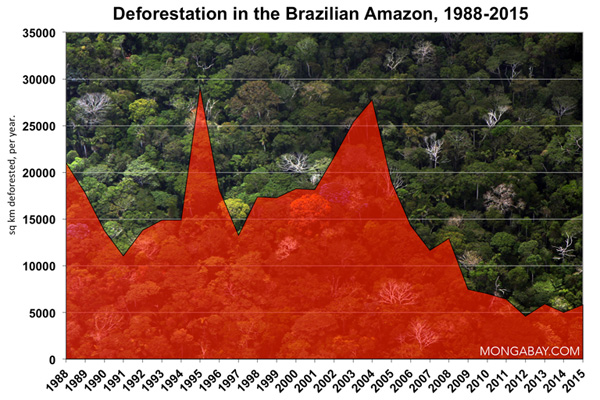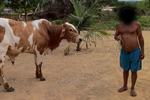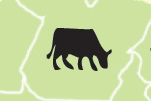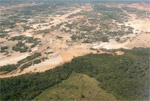2.7 billion tons of carbon dioxide emissions or 30 percent of the carbon associated with deforestation in the Brazilian Amazon between 2000 and 2010 was effectively exported in the form of beef products and soy, finds a new study published in the journal Environmental Research Letters. The research underscores the rising role that global trade plays in driving tropical deforestation.
The study, led by Jonas Karstensen of the Center for International Climate and Environmental Research in Oslo, Norway, looked at carbon emissions from beef and soy production in the Brazilian Amazon. It then calculated the share of these commodities that was exported to overseas markets.
The research found that Brazilian consumption is responsible for the vast majority of emissions from its own deforestation: 85 percent of emissions from in Brazilian beef products and 50 percent of emissions in soy products were driven by domestic consumption between 1990 and 2010. However over the past decade, the share of emissions attributable to commodity exports has increased sharply, with more Brazilian products being exported to China and Russia.
“With a consumption perspective, the share of responsibility for deforestation is divided among the global consumers. What, in one perspective is Brazil’s problem, is now a global problem” said Karstensen in a statement. “Particularly in the last decade, greater imports by emerging markets and industrialized countries have led to an increasing share of exported emissions from Brazil.”

Deforestation emissions in trade distributed among top importers of (a) beef and (b) soybeans from 1990 to 2010. In total, Brazil
(right vertical axis) is responsible for about 85% of the emissions from cattle, and 50% of the emissions from soybeans. Image and caption courtesy of Karstensen et al 2013.
According to the paper, 29 percent of emissions from deforestation in the Brazilian Amazon were due to soybean production and 71 percent were due to cattle ranching over the past decade. But emissions from soybeans fell substantially during the second half of the 2000s, possibly a partial consequence of a soy producer moratorium on rainforest conversion that was signed in 2006 after a damaging Greenpeace campaign. Overall emissions from deforestation in the Brazilian Amazon are declining in step with the falling rate of forest clearance, although rates outside the Brazilian Amazon — especially in Bolivia and Peru — appear to be on the rise, possibly as a consequence of agricultural development shifting across borders.
The paper adds to a growing body of research that shows a major shift in global drivers of deforestation from subsistence agriculture to industrial commodity production. The trend indicates that efforts to curb deforestation — like the nascent Reducing Emissions from Deforestation and forest Degradation (REDD)+ program — will have to address urban consumption to be effective. Focusing solely on small-holder agriculture will fail to reduce emissions from deforestation.

Annual deforestation rate in the Brazilian Amazon
CITATION: Jonas Karstensen, Glen P Peters, Robbie M Andrew. Attribution of CO2 emissions from Brazilian deforestation to consumers between 1990 and 2010. Environmental Research Letters, 2013; 8 (2): 024005 DOI: 10.1088/1748-9326/8/2/024005
Related articles
Brazilian supermarkets ban beef linked to Amazon deforestation
(03/27/2013) A group representing 2,800 Brazilian supermarkets has signed an agreement barring beef linked to deforestation in the Amazon rainforest from their shelves.
Gucci launches ‘zero-deforestation’ handbag

(03/07/2013) Gucci has rolled out a collection of ‘zero-deforestation’ leather handbags. Each handbag comes with a ‘passport’ that provides the history of the product’s supply chain going back to the ranch that produced the leather. The line emerged out of concerns that leather in the fashion industry is contributing to deforestation in the Brazilian Amazon, where roughly two-thirds of forest destruction is for cattle production.
Loans tied to environmental compliance reduced Amazon deforestation by 15%
(01/30/2013) A rural credit law that ties loans to environmental compliance made a significant contribution to reducing deforestation in the Brazilian Amazon between 2008 and 2011, argues a study published by the Climate Policy Initiative (CPI).
Forests, farming, and sprawl: the struggle over land in an Amazonian metropolis

(12/04/2012) The city of Parauapebas, Brazil is booming: built over the remains of the Amazon rainforest, the metropolis has grown 75-fold in less than 25 years, from 2,000 people upwards of 150,000. But little time for urban planning and both a spatial and mental distance from the federal government has created a frontier town where small-scale farmers struggle to survive against racing sprawl, legal and illegal mining, and a lack of investment in environmental protection. Forests, biodiversity, and subsistence farmers have all suffered under the battle for land. In this, Parauapebas may represent a microcosm both of Brazil’s ongoing problems (social inequality, environmental degradation, and deforestation) and opportunity (poverty alleviation, reforestation, and environmental enforcement).
Profit, not poverty, increasingly the cause of deforestation
(06/13/2011) A new report highlights the increasing role commodity production and trade play in driving tropical deforestation.
Can Brazil meet deforestation, climate goals and still grow its cattle industry?

(06/09/2011) Despite environmentalists’ efforts to combat “rainforest beef” in the 1980s, pasture expansion for cattle is still the primary cause of deforestation in the Brazilian Amazon, says a new report produced by Brighter Green. While Brazil’s investments in agribusiness have made it an agricultural powerhouse—the country is now the world’s third-largest exporter of farm commodities after the US and the European Union—unfortunately, two of the Brazil’s key products, cattle and soy, are still driving deforestation as well as economic growth. According to Brighter Green’s report, researchers estimate that cattle ranching caused 65-70 percent of land clearing in the Amazon between 2000 and 2005.
Corporations, conservation, and the green movement

(10/21/2010) The image of rainforests being torn down by giant bulldozers, felled by chainsaw-wielding loggers, and torched by large-scale developers has never been more poignant. Corporations have today replaced small-scale farmers as the prime drivers of deforestation, a shift that has critical implications for conservation. Until recently deforestation has been driven mostly by poverty—poor people in developing countries clearing forests or depleting other natural resources as they struggle to feed their families. Government policies in the ’60s, ’70s, and ’80s had a multiplier effect, subsidizing agricultural expansion through low-interest loans, infrastructure projects, and ambitious colonization schemes, especially in the Amazon and Indonesia. But over the past two decades, this has changed in many countries due to rural depopulation, a decline in state-sponsored development projects, the rise of globalized financial markets, and a worldwide commodity boom. Deforestation, overfishing, and other forms of environmental degradation are now primarily the result of corporations feeding demand from international consumers. While industrial actors exploit resources more efficiently and cause widespread environmental damage, they also are more sensitive to pressure from consumers and environmental groups. Thus in recent years, it has become easier—and more ethical—for green groups to go after corporations than after poor farmers.
Changing drivers of deforestation provide new opportunities for conservation

(12/09/2009) Tropical deforestation claimed roughly 13 million hectares of forest per year during the first half of this decade, about the same rate of loss as the 1990s. But while the overall numbers have remained relatively constant, they mask a transition of great significance: a shift from poverty-driven to industry-driven deforestation and geographic consolidation of where deforestation occurs. These changes have important implications for efforts to protect the world’s remaining tropical forests in that environmental lobby groups now have identifiable targets that may be more responsive to pressure on environmental concerns than tens of millions of impoverished rural farmers. In other words, activists have more leverage than ever to impact corporate behavior as it relates to deforestation.
Concerns over deforestation may drive new approach to cattle ranching in the Amazon

(09/08/2009) While you’re browsing the mall for running shoes, the Amazon rainforest is probably the farthest thing from your mind. Perhaps it shouldn’t be. The globalization of commodity supply chains has created links between consumer products and distant ecosystems like the Amazon. Shoes sold in downtown Manhattan may have been assembled in Vietnam using leather supplied from a Brazilian processor that subcontracted to a rancher in the Amazon. But while demand for these products is currently driving environmental degradation, this connection may also hold the key to slowing the destruction of Earth’s largest rainforest.
Activists target Brazil’s largest driver of deforestation: cattle ranching

(09/08/2009) Perhaps unexpectedly for a group with roots in confrontational activism, Amigos da Terra – Amazônia Brasileira is calling for a rather pragmatic approach to address to cattle ranching, the largest driver of deforestation in the Brazilian Amazon. The solution, says Roberto Smeraldi, founder and director of Amigos da Terra, involves improving the productivity of cattle ranching, thereby allowing forest to recover without sacrificing jobs or income; establishing a moratorium on new clearing; and recognizing the economic values of maintaining the ecological functions of Earth’s largest rainforest.
Beef consumption fuels rainforest destruction

(02/16/2009) Nearly 80 percent of deforestation in the Brazilian Amazon results from cattle ranching, according to a new report by Greenpeace. The finding confirms what Amazon researchers have long known – that Brazil’s rise to become the world’s largest exporter of beef has come at the expense of Earth’s biggest rainforest. More than 38,600 square miles has been cleared for pasture since 1996, bringing the total area occupied by cattle ranches in the Brazilian Amazon to 214,000 square miles, an area larger than France. The legal Amazon, an region consisting of rainforests and a biologically-rich grassland known as cerrado, is now home to more than 80 million head of cattle. For comparison, the entire U.S. herd was 96 million in 2008.